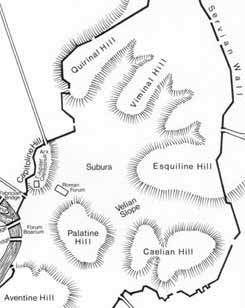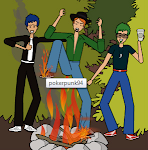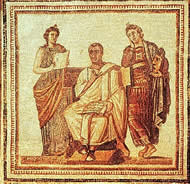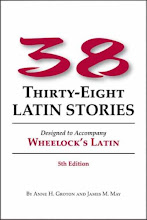I, Titus Tullius Sextus, finished my porridge and bread, wiped my mouth, strapped on my boots, and adjusted my toga. I stood and looked at the surrounding landscape, which we

nt on as far as the eye could see, past buildings and fields. I sighed. Another long day would be ahead of me. I would first go to the Temple of Veiovis to worship (where I wondered every day why the cella was wider than the front porch), and then I would walk my often-trodden path to the Asylum to give tours of
Capitolinus Mons (Capitoline Hill).
This was my job, to appeal to the strangers that entered the Asylum daily, to draw the interest of the travelers from afar. "Titus the Tour Guide" was my title. I would take my customers on a tour of the Asylum and Capitoline Hill, for a fair pay, which provided me with enough for my living.
I am a very knowledgeable guide, or at least I like to think so, but I am getting bored of the same old thing, day after day, rote recitation and routes. I long for something better, something new. I have a feeling this was my lucky day.
I was standing at the main entrance area of the Asylum, watching as the travelers from afar wandered through. I knew by now the right people to pick out. I looked for three things in a potential customer. For one, they could not be weary and tired, for they would never accept to the tour. For two, they should not be walking with purpose, because he could not interrupt their planned travels. For three, they must have enough payment for the tour.
I soon spotted a potential customer who was walking in my direction, or rather, I was spotted by a potential customer who was walking in my direction. This wasn’t normal, but I did my normal spiel of appeal for my tour. The customer was only too anxious, but he also seemed to be nervous. He was quickly looking both ways as if he was making sure he wasn’t followed. I didn’t catch this, so when the shady customer agreed and provided payment, I was only too happy to take this traveler on my first tour of the day.
I always began my tour on the Arx, the northern summit of the hill, which was the higher point of Capitoline Hill. The tour literally only went downhill from there. On the way to the Temple of Juno Moneta I spewed general information about the hill.
“The Capitoline Hill is the smallest of the seven hills of Rome. It is surrounded by steep cliffs on all sides except in the southeast where it is accessible from the Roman Forum. It is located between the Forum and the Campus Martius. It is also the religious center of the city. The northern and southern summits of the hill are divided by the Asylum, which is where we just came from. South of the Asylum are a few other temples, the most prominent of which is the Temple of Jupiter Optimus Maximus. The Capitoline Hill was a site for this temple for the Capitoline Triad, which are Jupiter, Juno, and Minerva. The temple was started under the rule of Rome’s fifth king Tarquin the Elder. Legend says that the recovery of a human skull (“head” in Latin is “caput”) while foundation trenches were being dug led to the name of the hill. When the Senones Gauls raided Rome in 390 BC, this was the one section of the city that evaded capture by the barbarians. Julius Caesar and the brother and nephew of Vespasian

also visited this hill. Also-“
“Excuse me”, the shady traveler interjected. “Can you tell me more about the Asylum?”
“I was getting to that”, I answered. “The Asylum is a grove in the depression between the two summits of Capitoline Hill (the Arx and the Capitolium). An asylum can be any place offering safety, shelter, and protection. Tradition states that Romulus invited visitors, settlers, a

nd refugees from afar in the Asylum. This began Rome’s policy of encouraging a diverse population.”
We arrived at the Temple of Juno Moneta. “This is a temple for Juno ‘who warns’. The Roman Mint is located here.” I then showed the stranger the amazing architecture including the marble columns and arches of the temple and then I showed him where the money was made.
When we were both finished, I told the stranger where we would travel next. We were going to the Capitolium to visit the Temple of Jupiter Optimus Maximus, the Temple of Fides, and the Aedes Tensarum. The Aedes Tensarum was first. I answered the traveler’s questions as we walked over. We strolled along as many others were busily hurrying all around. A sweet wind blew, which brightened my mood. I couldn’t get over the fact that the traveler man was jittery the whole time. I tried to wave it off in the back of my mind. When we arrived at the Aedes Tensarum, I began again.

“The Aedes Tensarum is a small temple where symbols of the gods during the theater festivals are stored. Chariots are also housed here.” We then walked to the Temple of Fides, saving the Temple of Jupiter Optimus Maximus for last. On the way to the temple of Fides, I saw a Roman man with a something sharp in his toga and wondered why he looked so mischievous. The traveler then clumsily bumped into him, and we continued on.
At the Temple of Fides I told the man, “This temple is dedicated to the goddess Fides.” I then went on to explain to him that this temple was different in its colorful archaic features. One such requirement was that the priests had to wrap their hands to symbolize the sacred nature of oaths. Senators also met here.
When we arrived at the Temple of Jupiter Optimus Maximus, I felt like I had already told him a lot about it. As I began to tell the man of the highlights of the temple, an actual light appeared near the altar. I walked over to check it out as the light turned into some kind of swirling portal to another area. I turned to wonder aloud to the man, but as I did he drew a knife. He must have pick pocketed it from the man near the Temple of Fides. He stared at me deviously. I looked at him closer and saw the uniform underneath his clothes. “You must have escaped from Carcer”, I said. Carcer was the ancient state prison of Rome at the bottom of the Capitoline Hill. He told me the truth, “Yes, then I stole a uniform from a man at the Temple of Concord. And before you ask, I am killing you to take your place and blend in. I will become you and will never be found.” He glared hungrily at me. On any other day I would have stayed away from the colorful tunnel, but today I spun and dove straight into it.
In the tunnel I wondered why such a portal would open up for me. I came out the other side of the tunnel in a familiar place. It was Capitoline Hill, but it was run down and looked old. I walked outside, confused, and asked the closest person I could see what happened. He told

me that the temples were over a thousand years old and that this ruin was bound to happen sometime.
I questioned him again. “What year is this?”
The man answered, “1536.”
My pride for the Hill overtook my confusion of time, place, etc. I told him, “I need to find the nearest architect to fix these buildings.”
He raised his hand slowly and looked down. “I’m an architect”, he said. He looked sad.
“Well great! You can help rebuild and improve these places. I can even help you with them.” He still looked sad. “Come on”, I begged him. “Please, you must help me. This place has a h

uge historical importance. You must help.”
He finally agreed. “Glad to do business with you”, I said to the man. “My name is Michelangelo”, he said. “And I’m glad to help, too!”
Years passed. The church of Santa Maria de Aracoeli was built at the Arx. The Piazza del Campidoglio and the surrounding palazzos were designed by Michelangelo, who decided to orient the Capitoline towards St. Peter’s Basilica. Still, the Hill was restored, so I was satisfied. Capitoline Museums then opened. I helped bring back the Capitoline. I decided that my purpose of coming into the future must have been to start off Michelangelo. This always confused me. And when I figured out that Rome was gone I almost died, but hey, this was a new start, just like I wanted…
















